Top UV Flashlights for Spotting Yooperlites in Michigan
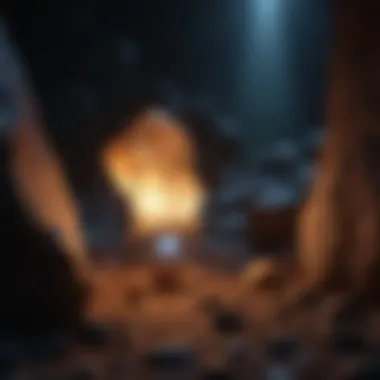

Intro
In the realm of rock hunting, few activities stir excitement quite like seeking out yooperlites. These fascinating minerals, known for their unique fluorescence under ultraviolet light, have captivated both casual collectors and serious geologists alike. As you're embarking on your quest to discover these glow-in-the-dark gems, you'll want to be equipped with the right tools. Enter the UV flashlight—a game changer that turns a normal trek into an illuminating adventure.
In this piece, we’re diving into the best UV flashlights for hunting yooperlites, which should help you unearth these treasures of Michigan's Upper Peninsula. We'll highlight what sets apart the top options available today, share users' experiences, and arm you with techniques to identify yooperlites with ease.
This guide aims to illuminate not just the products but also the methodology behind effective rock hunting. With the right UV flashlight in hand and an eye for detail, you can maximize your chances of discovering these special stones that are more than just rocks; they're geological wonders carrying a story of their own.
Featured Collectible of the Month
Overview
Each month, yooperlites claim the spotlight as a collectible item cherished by enthusiasts. Their unique glowing property when exposed to UV light is tied to the presence of fluorescent minerals such as sodalite. When nestled throughout the beautiful landscapes of Michigan, they emerge as stunning finds that sparkle under the right conditions. With increasing popularity, these stones not only hold substantial personal value but can also fetch a pretty penny in the collector's market.
Historical Significance
Yooperlites are not mere geological marvels; they hold tales of ancient landscapes that once thrived millennia ago in Michigan. Discovered relatively recently, these stones have sparked interest in the field of fluorescence and mineralogy. Their allure is heightened by the scarcity and the actual conditions under which they were formed, primarily linked to the geological processes of the region. The history that surrounds each luminescent specimen adds depth to its aesthetic value, echoing a time when the Earth's processes shaped minerals that would, one day, dazzle onlookers with their glow.
Identification Techniques
Visual Characteristics
When hunting for yooperlites, developing an eye for the specific visual markers that set them apart from regular rocks is crucial. Look for:
- Color Variations: They often present a variety of hues that can range from gray to tan, with visual streaks or patterns that catch the eye.
- Texture: Smooth, rounded shapes are common; some may even bear unique surface textures due to weathering.
- Weight: They are generally lighter compared to other stones, given their unique composition.
Resources for Identification
Identifying yooperlites can be daunting for newcomers, but several resources can enhance your skills:
- Local Mineral Shows: Engage with other collectors to share insights and best practices.
- Online Forums: Platforms like Reddit are treasure troves of information where enthusiasts share tips and findings.
- Books and Guides: Texts about Michigan's geology often feature sections dedicated to identifying regional minerals, perfect for both beginners and experts alike.
"Understanding the characteristics of yooperlites not only improves your skills but also deepens your appreciation for the geological history they represent."
As you move further into your exploration, remember that even the thrill of the hunt is as significant as the discovery itself. Combining the right UV flashlight with a solid grasp of these identification techniques enhances your chances of success. This guide will continue to unpack the intricacies of using UV flashlights effectively, offering practical tips that could be the key to uncovering those stunning finds.
In upcoming sections, we will delve deeper into specific flashlight recommendations, reviews based on user feedback, and expert tips to refine your rock-hunting adventures. Happy collecting!
Prolusion to Yooperlites
Finding Yooperlites can be an exhilarating adventure for those interested in geology and rock collecting. Originating from Michigan's Upper Peninsula, these unique stones glow under UV light, making them quite the catch for rock hounds. Their fluorescent properties not only make them visually stunning but also have significant geological implications worth exploring. This section dives into the essentials of Yooperlites, their defining traits, and why they have captured the imagination of collectors and enthusiasts alike.
Definition and Characteristics
Yooperlites, or Lepidolite, are a type of fluorescent syenite rock enriched with sodalite and various other minerals. When exposed to UV light, they emit a brilliant, vibrant glow. They're primarily found along the shores of Lake Superior, where erosion has worn them down over time. The efficacy of UV light on these rocks stems from the presence of specific minerals, notably feldspar and sodalite, that interact uniquely with ultraviolet rays.
A few key characteristics include:
- Coloration: While they typically appear gray or tan in regular light, their luminescence can range from bright green to blue under UV light.
- Texture: Most Yooperlites are rough and uneven, with a rugged surface that adds to their natural allure.
- Size: They can vary greatly in size, from tiny pebbles to larger stones as big as a fist.
Understanding these characteristics ensures collectors are well-prepared when searching for specimens in their natural habitat.
The Geological Significance of Yooperlites
The importance of Yooperlites extends beyond their aesthetic appeal. They provide insights into the geological history of Michigan and the processes that formed the landscape of the Upper Peninsula. Their unique composition is indicative of specific conditions present during the rock's formation.
For instance, the fluorescent ability suggests that these minerals underwent a distinct crystallization process influenced by environmental changes over millennia. Studying Yooperlites can offer significant findings related to:
- Mineral Formation: Understanding how these minerals came to be can shed light on broader geological processes affecting the region and beyond.
- Erosion Patterns: Their distribution and accessibility highlight the erosive forces at play in shaping the landscape along Lake Superior.
- Environmental Indicators: Changes in the mineral composition of Yooperlites can serve as indicators of past environmental conditions.
Thus, the significance of these rocks goes far beyond simple curiosity; they open a window into the Earth's past and allow collectors to engage with science in a tangible way.
Where to Find Yooperlites
Searching for Yooperlites is like embarking on a treasure hunt, and the best spots are often along the shores of Lake Superior. Several locales are particularly renowned for containing these glowing gems:
- Lighthouses and Beaches: Areas near iconic lighthouses, like those in Big Bay or the shores of Presque Isle Park, are known for abundant Yooperlite sightings.
- Rocky Shores: The rocky, pebbled shores mixed with sand offer the best chance of finding these rocks, especially after storms that disturb the shoreline.
- Local Lakes and Rivers: Beyond Lake Superior, smaller local bodies of water can be fruitful hunting grounds if they have similar geological formations.
When searching for Yooperlites, it's best to time your hunts during low tide or right after a rainfall — conditions like these expose more of the shoreline, increasing the likelihood of finding these gems.
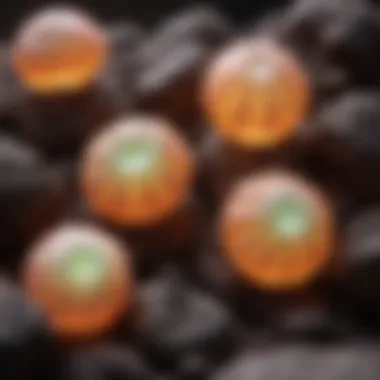
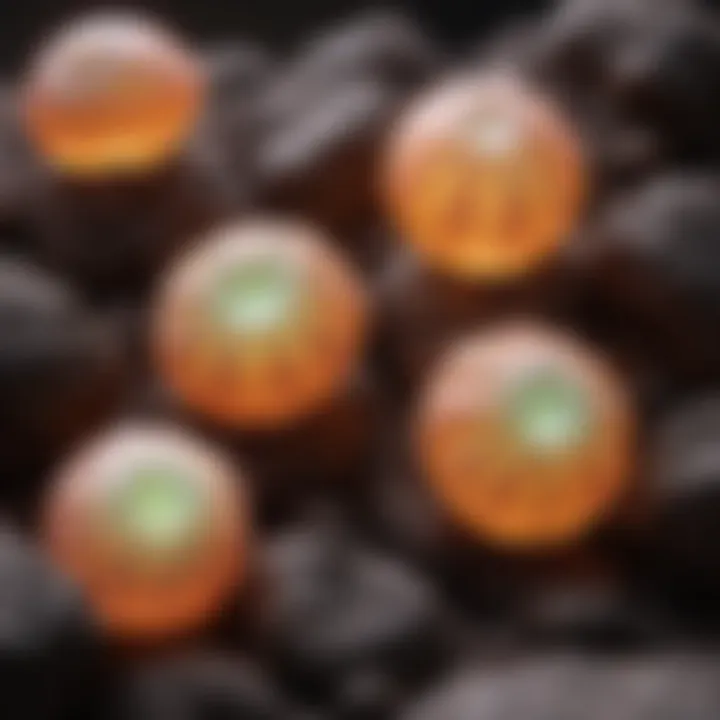
Collecting Yooperlites is not just about what you see under UV light; it’s a connection to the earth’s evolution and an appreciation for nature's artistry and science intertwined.
With this foundational knowledge about Yooperlites, rock collectors can confidently embark on their expeditions, armed with insights into where to look and what to expect. As we explore UV light and its connection to these geological treasures, understanding the broader context enriches the hunt.
Understanding UV Light
Understanding UV light is crucial for getting the most from your exploration into the world of yooperlites. This light is not just a gimmick; it plays a significant role in how these fascinating rocks reveal their true colors. Using the right type of UV light can mean the difference between stumbling around in the dark and spotting that elusive glow. This section will shed light on the different types of UV light and how they interact with minerals, particularly yooperlites, enhancing your rock-finding endeavors.
Types of UV Light
Diving into the types of UV light is like lifting the curtain on a magic show. Each type has its own quirks and characteristics that can influence which yooperlites catch your eye.
UVA
UVA light is the most commonly used type when it comes to searching for fluorescent minerals. It has the longest wavelength of the three types, ranging from 320 to 400 nanometers. This means it's not as powerful as UVB or UVC, but it does have a critical advantage: it can excite many minerals without causing them to deteriorate.
A key characteristic of UVA is that it often makes minerals glow in bright, vibrant colors. For yooperlites, this means you’ll likely see bright orange or yellow hues when they're exposed to UVA light. This can be striking against a dark background, making your hunting expeditions much more fruitful. However, the downside is that it might miss some minerals that require stronger light to fluoresce.
UVB
UVB light operates in a somewhat shorter wavelength, ranging from 280 to 320 nanometers. This type of UV light is more intense, which means it can excite more minerals than UVA can. It’s particularly effective for fluorescing minerals that require a stronger push to shine.
One of the notable features of UVB is its ability to reveal more subtle fluorescence that might be hidden under the gentler touch of UVA. For instance, if you’re after a broad spectrum of yooperlites, UVB could help uncover some unique specimens. But, the higher intensity can also pose a risk; prolonged exposure to UVB can potentially damage the minerals and can be harmful to your skin and eyes without proper protective gear.
UVC
UVC light sits at the far end of the spectrum, ranging from 100 to 280 nanometers. While it may seem like the heavyweight contender, its application in rock hunting is limited. UVC light is particularly effective for sanitization purposes due to its powerful germicidal properties. However, it is not generally useful for fluorescent mineral hunting because it does not excite them in the same way as UVA or UVB.
A key characteristic of UVC is its potential indifference to fluorescence; yooperlites and other minerals may not respond to UVC light the way they do to the other types. The benefits are mainly in lab situations or industrial applications, making it less favorable for collectors who wish to spot glowing rocks in the wild. It's also worth noting that UVC can be detrimental to both skin and eyes, necessitating even more caution than UVB.
How UV Light Affects Minerals
When it comes to how UV light interacts with minerals, it’s not all black and white. The type of UV light can determine the kind of fluorescence exhibited by the minerals, making the choice of light critical for finding yooperlites. Generally, minerals absorb the energy from the UV light and then re-emit it at a longer wavelength, which is what we perceive as color. Understanding these interactions helps in choosing the right UV flashlight that matches the specific characteristics of yooperlites, ensuring that your rock hunting experience is efficient and enjoyable.
Selecting a UV Flashlight
Choosing the right UV flashlight is crucial for effectively finding yooperlites. These rocks, known for their unique fluorescent characteristics under UV light, require a specialized tool to uncover their hidden beauty. This section delves deep into the considerations for selecting a UV flashlight, helping enthusiasts make an informed decision that can enhance their collecting experience.
Key Features to Consider
Wavelength Range
When it comes to UV flashlights, the wavelength range is the bread and butter of performance. Most minerals, including yooperlites, tend to fluoresce best in specific ranges, primarily under UVA light, which ranges from 320 to 400 nanometers. Choosing a flashlight that operates in this range can significantly enhance the visibility of these minerals.
The key characteristic here is that ultraviolet light tends to bring out the vibrant colors inherent in yooperlites, showing off their bright oranges, yellows, and greens. This makes a UV flashlight with a peak wavelength of around 365 nm quite popular among collectors. However, there are trade-offs; while longer wavelengths can illuminate more, they may not produce the vivid fluorescence that shorter wavelengths do. Therefore, it’s wise to balance between variety and opportunity when choosing a flashlight.
Intensity and Brightness
Intensity and brightness of a UV flashlight directly impact how effectively you can spot yooperlites during your hunt. A strong intensity allows for penetrating darker areas, making it easier to reveal those elusive glowing rocks.
Flashlights that emit higher lumens are particularly beneficial. They illuminate the ground more broadly, casting a larger area of light. However, a flashlight that is too intense can create glare, making details harder to discern. Thus, a balance in brightness is paramount, as you don’t want to lose sight of finer details hidden in the shadows or overwhelmed by too much light.
Battery Life
Considering the battery life of a UV flashlight can save you from the inconvenience of replacements mid-adventure. A flashlight boasting a longer battery life is not only economical but offers peace of mind during extended outings. Enthusiasts often prefer models that can run for several hours without needing a charge.
The uniqueness of a flashlight’s battery life lies in the type of batteries it uses. For example, some flashlights rely on rechargeable lithium-ion batteries, which tend to have an extended lifecycle compared to disposable alkaline batteries. The main drawback here is the need to plan ahead to ensure you have a functioning flashlight ready to go.
Different Flashlight Types
Handheld Flashlights
Handheld flashlights are versatile tools that allow you to easily direct light where you need it on your search for yooperlites. Their portable nature makes them an obvious choice for collectors who might traverse rocky or uneven terrain.
One of their standout features is their ergonomic design, which fits comfortably in the hand, allowing for lengthy searches without discomfort. They usually have adjustable beam settings and some come with filters to customize the light.
However, the downside is that stationary locations may not benefit much from handhelds since you’ll be required to keep moving it to get a good look at the ground, which might lead to tired arms after a while.
LED Flashlights
LED flashlights have become a favorite among many rock collectors due to their durability and efficiency. While providing a decent intensity, they are also economical when it comes to energy usage. LED bulbs have a reputation for longevity - they can last for many years without needing to change.
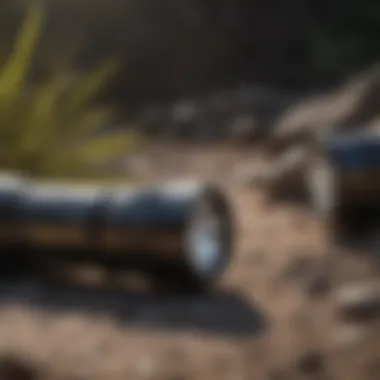

Moreover, they offer a compact design that’s often lightweight, making them easy to carry during long excursions without the extra weight. On the flip side, some users may find that despite their endurance, LED flashlights can present a narrower beam which might miss out on finds scattered over a wider area.
Rechargeable Options
Rechargeable UV flashlights offer convenience that can’t be ignored. They come with built-in batteries that can be easily charged, making them an eco-friendly choice. As these flashlights often yield a longer runtime per charge, they appeal strongly to regular collectors.
Among the unique features of rechargeables is their capacity to retain power for extended periods without a loss in intensity, often outlasting traditional batteries. Nonetheless, they can be on the pricier side, and users must be conscious of ensuring they are charged before embarking on trips.
"Choosing the right UV flashlight not only enhances your ability to find yooperlites but also enriches your overall collecting experience."
In summary, selecting the appropriate UV flashlight can significantly boost your success in locating those radiant yooperlites. Consider the wavelength range, brightness, and battery life as essential elements tailored to your needs and preferences. No two collectors are alike, and finding the right tool often comes down to personal preference and intended use.
Top Recommendations for UV Flashlights
When it comes to successfully hunting for yooperlites, the right UV flashlight is an essential tool to have in your inventory. Your choice in flashlight can significantly impact your discovery process, as not all UV lights are born equal. Just like trying to find a needle in a haystack, having a high-quality flashlight can mean the difference between striking gold and wandering home with empty hands.
Here, we break down choices that cater to different needs and budgets. From high-powered flashlights designed for serious collectors to compact options perfect for the newcomer, there’s something for everyone. Let’s shed some light—figuratively and literally—on what’s essential when choosing UV flashlights for your yooperlite expeditions.
High-Powered UV Flashlights
For those who take their rock hunting seriously, investing in high-powered UV flashlights is a no-brainer. These devices generally produce a more intense beam of UV light, which enhances visibility and makes the fluorescent properties of yooperlites pop like stars in the night sky. They typically range in wavelength from 365 to 395 nanometers, getting you closer to that sweet spot for fluorescent minerals.
Benefits:
- Enhanced Visibility: Higher intensity leads to better fluorescence detection.
- Durability: Often built to withstand rough handling in outdoor conditions.
- Versatility: Useful beyond yooperlites; they can reveal other fluorescent materials too.
Your top choices in this category often include brands like Streamlight and Thrunite, which are both reputed among seasoned collectors for their reliability and effectiveness. A high-powered flashlight isn’t just a tool; it’s an investment in your passion.
Budget-Friendly Options
Not everyone is ready to shell out big bucks for a UV flashlight. Luckily, several budget-friendly options don’t skimp on performance and can still make your yooperlite hunt fruitful. When your budget is tight, you can still find decent flashlights that fall within an affordable price range, typically around $20 to $50.
Key Considerations:
- Wavelength Range: Even budget models can offer decent wavelength coverage, typically around 395 nanometers.
- Functionality: Look for flashlights with simple on/off switches and minimal extra features.
- Portability: Many budget models come in compact designs for easy carrying.
Brands like UltraFire and J5 Tactical often produce reliable low-cost options. Don’t be fooled by the price; these flashlights can still uncover some impressive finds, especially for those just starting out.
Portable UV Flashlights
For those who like to travel light—and who doesn’t when hunting for yooperlites?—portable UV flashlights come in handy. These are usually more compact and designed to be easy to carry, ensuring you have your light by your side without the added weight.
Features to Look For:
- Lightweight Design: Easy to slip into a backpack or pocket.
- Rechargeable Battery: A great feature to avoid running out of juice in the middle of your search.
- Multiple Modes: Some models allow you to switch between different intensities or light types, increasing versatility depending on your needs.
Olight and Ansmann are notable brands in this category. A portable UV flashlight can be a great companion, ensuring that you’re always prepared to uncover the hidden treasures of the geological world, no matter where your adventures take you.
"In rock hunting, sometimes it’s not just the destination, but also the gadgets that guide your way. Select wisely!"
By evaluating your specific needs—whether it's power, budget, or portability—you'll ensure that your yooperlites mining experience is both successful and enjoyable.
Using a UV Flashlight Effectively
Finding yooperlites requires skill and the right equipment, and using a UV flashlight correctly is essential in this pursuit. Proper utilization of a UV flashlight enhances your ability to spot these fascinating stones and brings them to life in the dark, showcasing their glow and brilliance. Not only does effective use save time and effort, but it also maximizes the yield of your rock hunting experience. Here, we discuss best practices, safety precautions, and effective techniques to ensure you get the most out of your flashlight adventures.
Best Practices for Finding Yooperlites
Timing and Conditions
Timing and conditions are critical elements when hunting for yooperlites. The optimal time is during warm summer nights or after a fresh rain when cooling temperatures can aid visibility. The dark provides the necessary environment for the fluorescence to stand out against the surrounding terrain. Therefore, accordingly picking your time not only heightens your chance of catching sight of these elusive specimens but also influences the kind of illumination you're dealing with during your search.
Weather plays a significant role in visibility. Clear skies can brighten the night for you, while moonlight may drown out the brilliance of lesser-glowing stones. Avoiding cloudy or stormy evenings is wise, as overcast conditions can put a damper on your hunting success potential. Picking the right conditions is about more than mere luck; it’s an informed choice that can lead to a fruitful hunt.
Methodology for Scanning
A systematic approach to scanning the ground is a strong determinant of your success rate for finding yooperlites. Start by walking slowly on uneven terrain and move in a sweeping motion with your UV flashlight, ideally a beam that spans the front yard’s width. This allows for a more thorough examination, ensuring no stone is left unturned.
A common technique is using a zig-zag pattern. Instead of scanning in straight lines, this approach helps cover more ground without missing potential spots where yooperlites may be hidden under rocks or debris. This unique scanning style maximizes your efficiency — think of it as combing through a thick forest versus looking for a single object in an open field. It’s a small adjustment in methodology that can yield significant results.

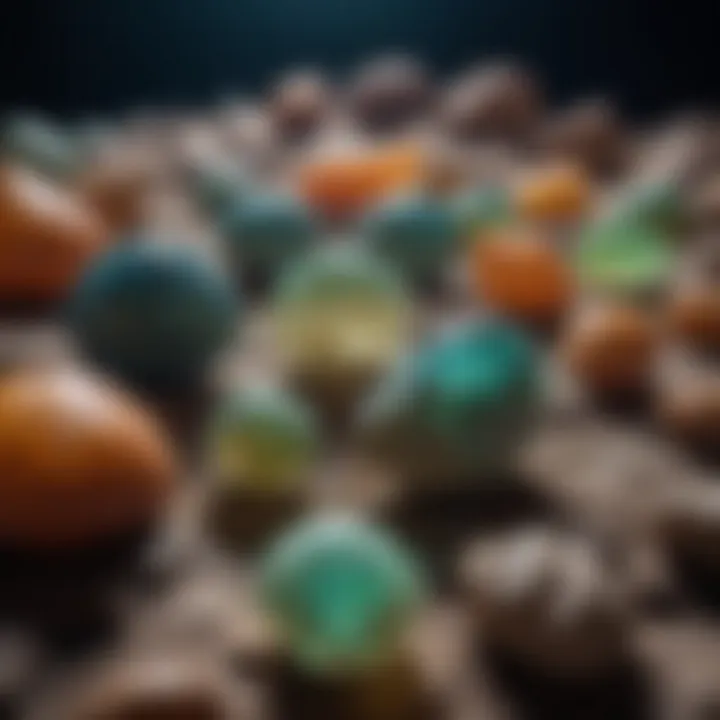
Safety Precautions
Wear Protective Eyewear
The importance of wearing protective eyewear cannot be overstated. UV light, while thrilling for spotting yooperlites, can damage your eyes over time. A good pair of UV-resistant glasses can shield your vision from potential harm. This isn’t just an accessory; it serves as an essential line of defense during your rock-hunting expedition.
The right protective eyewear often features a wraparound design, ensuring that light doesn’t sneak in from the sides. Opting for something that meets safety standards is vital, allowing you to enjoy the hunt without risking eye strain or injury from prolonged exposure.
Avoiding Skin Exposure
As UV light can affect your skin, being mindful of your exposure time is crucial. It's not just a matter of comfort; direct, prolonged exposure can increase your risk of skin damage. Wearing long sleeves, pants, and a hat can significantly mitigate this risk, making your hunt more pleasant and safer.
The practice of limiting exposure not only helps in protecting your skin but also provides the ability to focus on your search without distractions. This practical choice lets you dive deep into your rock hunting activities, free from discomfort or worry. Remember, safety should always take precedence over a glamorous glow.
In summary, employing proper techniques for using a UV flashlight, understanding the impact of timing and conditions, and adhering to safety precautions will vastly improve your chances of finding yooperlites. Collecting is not just about the rocks; it's about enjoying a safe, successful experience.
Caring for Your Collection
Caring for your yooperlite collection is a vital aspect of being a responsible and passionate collector. Just like any other type of collectible, these unique stones require proper handling and care to preserve their beauty and enhance their value over time. With their intriguing fluorescence, yooperlites not only capture the eye but also offer stories of their geological origin. Thus, knowing how to care for these specimens is essential for any serious enthusiast.
Best Ways to Store Yooperlites
When it comes to storage, a well-thought-out approach can make all the difference. Here are some recommendations to properly store your yooperlites:
- Use Soft Containers: Soft pouches or fabric-lined boxes can help prevent scratches or impact damage. Consider using materials like velvet or felt that are gentle on the surface.
- Avoid Direct Sunlight: Exposure to direct sunlight can fade the vibrancy of the colors and fluorescence. Store your collection in a shaded area, perhaps in a cabinet or drawer.
- Separate Each Piece: To avoid chips or breakage, keep each yooperlite in its own compartment. You could use dividers within a collection box or individual bags.
- Maintain Steady Temperature: Extreme temperature changes can lead to cracks in the stones. Aim for a cool, stable environment free from high humidity.
Implementing these practices not only keeps your yooperlites looking pristine but also ensures their longevity as cherished items in your collection.
Cleaning and Maintenance
Cleaning yooperlites needs to be approached with a gentle hand. The right techniques can enhance their glow without causing harm:
- Gentle Washing: Use lukewarm water mixed with a mild soap to lightly scrub your stones. A soft toothbrush is ideal for tackling dirt and debris without scratching.
- Avoid Harsh Chemicals: Steer clear of bleach or strong detergents which can damage the stones’ surfaces.
- Drying Properly: After cleaning, ensure your yooperlites are dried completely to prevent moisture build-up. A soft towel can help, but it’s wise to let them air dry as well.
Proper maintenance ensures that your yooperlites shine bright and remain the focal point of your collection for years to come.
By following these guidelines for storage and cleaning, collectors can maintain the dazzling allure of yooperlites while safeguarding the investment that comes with a unique hobby. This care underlines the respect for nature and enhances pride in the geological treasures we are fortunate to collect.
Further Resources and Community Engagement
Engaging with the world of yooperlite hunting goes beyond the thrill of discovering these fascinating rocks. It invites collectors, both new and seasoned, to delve into a rich tapestry of community knowledge and shared experience. Exploring further resources and getting involved in community interactions can truly elevate the yooperlite hunting experience by expanding the collector's understanding, offering support, and fostering connections with others who share the same passion for these unique geological treasures.
Online Communities and Forums
Diving into online communities dedicated to rock and mineral collecting is a great way to enhance your expertise. Platforms like Reddit and Facebook have various groups where enthusiasts share tips, tricks, and personal stories about their yooperlite findings. Participating in these forums is not only a chance to gather information but also to ask questions, learn from others' mistakes, and perhaps share your own experiences. Some notable subreddits include:
- r/minerals
- r/rockhounds
Joining these forums gives you access to a diverse range of topics. Members often post their discovery successes, unique tales about local geological areas, and photos that showcase their collections. Plus, these forums can be a resource for buying, trading, or selling your finds.
Recommended Reading and References
For those serious about rock collecting, a solid foundation of knowledge is essential. There is a variety of literature available that focuses specifically on yooperlites and the broader scope of fluorescent minerals. Some recommended books include:
- "Fluorescent Minerals: A Guide to Collecting"
- "Amazing Yooperlites: A Collector's Handbook"
Diving into these texts will deepen your understanding of the science behind fluorescence and the geological significance of yooperlites. Not only do they provide detailed information about identifying and collecting these minerals, but they also give context about their geological formations and environments. Additionally, academic sites like Britannica or specialized geological journals present extensive research findings that enrich the context of your collections with their scientific data.
Closure
As we wrap up this exploration of UV flashlights for finding yooperlites, it's noticeable that the intersection of science and hobbyist interest creates a meaningful narrative. Understanding the deeper connection between the tools used and the phenomena observed enhances the entire experience. By selecting the right flashlight, collectors aren’t merely embarking on a search for unique rocks; they are participating in a scientific endeavor that reveals nature's hidden wonders.
The Intersection of Science and Hobby
Rock hunting often straddles the line between a laid-back hobby and rigorous scientific exploration. For many, learning about the various minerals and their characteristics is just as thrilling as finding them. A good UV flashlight effectively brings to light not just yooperlites but also the fascinating world of fluorescence — a rare quality in geological specimens. Collectors become researchers, analyzing the geological history and the luminescent properties of stones. It's a unique blend of curiosity and education.
- Understanding UV light helps collectors appreciate why certain rocks will glow under its illumination.
- A good flashlight can transform a routine search into a more exhilarating endeavor, revealing the beauty contained within ordinary stones.
Connecting science to leisure creates deeper engagement, inviting enthusiasts to dig into resources, from scholarly articles on minerals to informal discussions on forums like Reddit.
The Joy of Collecting
The joy of collecting is often derived from the thrill of the hunt, the satisfaction of discovering a new specimen, and the delight of sharing findings with other enthusiasts. Owning a collection of yooperlites is more than just possessing rocks; it's about the stories those rocks tell—stories of geological processes, personal adventures, and camaraderie among fellow collectors.
- It's the community aspect that makes this hobby extra special; through Facebook groups or local meet-ups, collectors exchange tips and stories, further enriching their passion.
- The act of finding and caring for these unique specimens can foster a sense of accomplishment and pride.
In the end, each shiny yooperlite isn’t just a trophy; it's a testament to the exploration and curiosity that drives many in the field of geology and mineralogy. Through the lens of both science and hobbyist passion, the act of collecting transforms into a meaningful pursuit that celebrates nature’s artistry.



